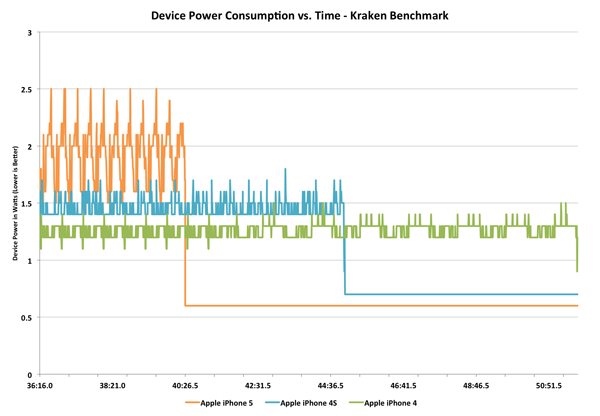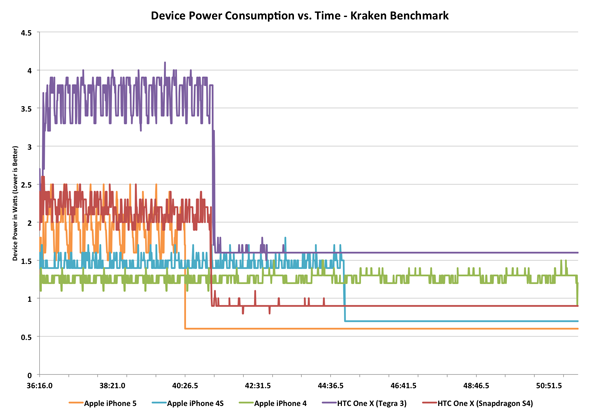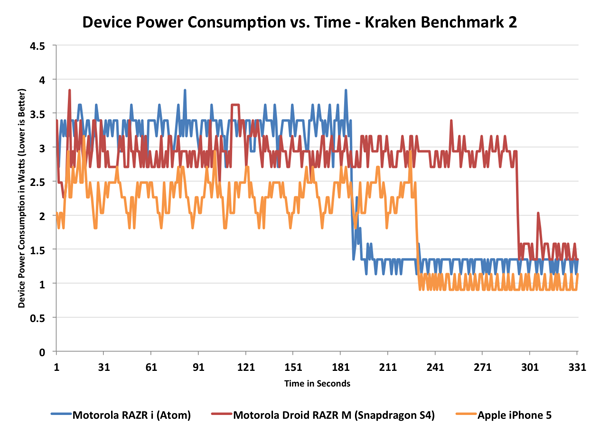The iPhone 5 Review
by Anand Lal Shimpi, Brian Klug & Vivek Gowri on October 16, 2012 11:33 AM EST- Posted in
- Smartphones
- Apple
- Mobile
- iPhone 5
Increased Dynamic Range: Understanding the Power Profile of Modern SoCs
Section by Anand Shimpi
The iPhone 4S greatly complicated the matter of smartphone power consumption. With the A5 SoC Apple introduced a much wider dynamic range of power consumption to the iPhone than we were previously used to. Depending on the workload, the A5 SoC could either use much more power than its predecessor or enjoy decreased overall energy usage. I began our battery life analysis last time with some graphs showing the power savings realized by a more power hungry, faster CPU.
The iPhone 5 doesn't simplify things any more. I believe the days of us having straightforward discussions about better/worse battery life are long gone. We are now firmly in the era of expanded dynamic range when it comes to smartphone power consumption. What do I mean by that? The best way to explain is to look at some data. The graphs below show total device power consumption over time for a handful of devices running the Mozilla Kraken javascript benchmark. Kraken is multithreaded and hits the CPU cores fairly well. The power profile of the benchmark ends up being very similar to loading a very js-heavy web page, although for a longer period of time. All of the device displays were calibrated to 200 nits, although obviously larger displays can consume more power.
Let's start out by just looking at the three most recent iPhone generations:
The timescale for this chart is just how long the iPhone 4 takes to complete the Kraken benchmark. The iPhone 4/4S performance gap feels a lot bigger now going back to the 4 than it did when the 4S launched, but that's how it usually seems to work. Note how tight the swings are between min and max power consumption on the iPhone 4 during the test. As a standalone device you might view the iPhone 4 as being fairly variable when it comes to power consumption but compared to the 4S and 5 it might as well be a straight line.
The 4S complicated things by consuming tangibly more power under load than the 4, but being fast enough to complete tasks in appreciably less time. In the case of this Kraken run, the 4S consumes more power than the 4, however it's able to go to sleep quicker than the 4 and thus draw less power. If we extended the timeline for the iPhone 4 significantly beyond the end of its benchmark run we'd see the 4S eventually come out ahead in battery life as it was able to race to sleep quicker. The reality is that with more performance comes increased device usage - in other words, it's highly unlikely that with a 50% gain in performance users are simply going to continue to use their smartphone the same way as they would a slower device. Usage (and thus workload) doesn't remain constant, it's somewhat related to response time.
The iPhone 5 brings new meaning to device level power consumption. With a larger display and much more powerful CPU, it can easily draw 33% more power than the 4S under load, on average. Note the big swings in power consumption during the test. The A6 SoC appears to be more aggressive in transitioning down to idle states than any previous Apple SoC, which makes sense given how much higher its peak power consumption can be. Looking at total energy consumed however, the iPhone 5 clearly has the ability to be more power efficient on battery. The 5 drops down to iPhone 4 levels of idle power consumption in roughly half the time of the iPhone 4S. Given the same workload that doesn't run indefinitely (or nearly indefinitely), the iPhone 5 will outlast the iPhone 4S on a single charge. Keep the device pegged however and it will die quicker.
Out of curiosity I wanted to toss in a couple of other devices based on NVIDIA and Qualcomm silicon to see how things change. I grabbed both versions of the HTC One X:
The Tegra 3 based One X actually performs very well in this test, but its peak power consumption is significantly worse than everything else. It makes sense given the many ARM Cortex A9 cores built on a 40nm G process running at high clock speeds on the Tegra 3.
The 28nm Snapdragon S4 (dual-core Krait) based One X gives us some very interesting results. Peak power consumption looks identical to the iPhone 5, however Apple is able to go into deeper sleep states than HTC can with its S4 platform. Performance is a little worse here but that could be a combination of SoC and software/browser. I used Chrome for all of the tests so it should be putting Android's best foot forward, but the latest update to Safari in iOS 6 really did boost javascript performance to almost untouchable levels.
At the end of the day, the power profile of the iPhone 5 appears to be very close to that of a modern Snapdragon S4 based Android smartphone. Any battery life gains that Apple sees are strictly as a result of software optimizations that lead to better performance or the ability to push aggressively to lower idle power states (or both). It shouldn't be very surprising that these sound like a lot of the same advantages Apple has when talking about Mac battery life as well. Don't let the CPU cores go to sleep and Apple behaves similarly to other device vendors, but it's really in idle time or periods of lighter usage that Apple is able to make up a lot of ground.
There's one member of the modern mobile SoC market that we haven't looked at thus far: Intel's Medfield. The data below isn't directly comparable to the data above, my measurement methods were a little different but the idea is similar - we're looking at device level power consumption over time while Kraken runs. Here I'm only focusing on the latest and greatest, the Atom based Motorola RAZR i, the Snapdragon S4 based Droid RAZR M and the iPhone 5. The RAZR i/M are nearly identical devices making this the perfect power profile comparison of Atom vs. Snapdragon S4. The RAZR i is also the first Atom Z2460 based part to turbo up to 2.0GHz.
Very interesting. Atom is the only CPU that can complete the Kraken benchmark in less time than Apple's Swift. Peak power consumption is definitely higher than both the Qualcomm and Apple devices, although Intel's philosophy is likely that the added power usage is worth it given the quicker transition to idle. Note that Atom is able to drive to a slightly lower idle level than the Snapdragon S4, although the Swift based iPhone 5 can still go lower.
At least based on this data, it looks like Intel is the closest to offering a real competitor to Apple's own platform from a power efficiency standpoint. We're a couple quarters away from seeing the next generation of mobile SoCs so anything can happen next round, but I can't stress enough that the x86 power myth has been busted at this point.
I will add that despite Intel's performance advantage here, I'm not sure it justifies the additional peak power consumption. The RAZR i ends up being faster than the iPhone 5 but it draws substantially more power in doing so, and the time savings may not necessarily offset that. We'll see what happens when we get to our battery life tests.













276 Comments
View All Comments
Spunjji - Friday, October 19, 2012 - link
Incorrect. See HP Elitebook, Sony Vaio S15, Asus Zenbook, etc... that does depend on your definition of "trackpad that doesn't suck", but personally I'd take an Elitebook with actual buttons over the Apple effort any day, so that bit really is swings and roundabouts.doobydoo - Friday, October 19, 2012 - link
'so that bit really is swings and roundabouts'That's like saying a Ferrari is overpriced because you prefer cup holders so therefore you get more car for less when you buy a Skoda.
Also, you have to consider size, weight, battery life and performance.
You can't find a single laptop which matches the air on all of the above.
Sufo - Tuesday, October 16, 2012 - link
You're right to an extent, however it's worth mentioning that it's a lot easier to find unlocked non-apple phones at good prices on auction sites etc. It's very hard to get much less than list price on iphones, even several months after release.As for Macs, it depends entirely on which country you buy them in - in the UK for example, it is cheaper to buy a plane ticket to the States and buy a 15" w/ retina there than it is to buy one locally - the same could not be said for similarly specced PCs.
Spunjji - Friday, October 19, 2012 - link
Truth. Unfortunately Apple prices are subject to the perception that Apple products hold their value better, which in a purely practical sense really isn't any more true than for any other product. But the market does as the market does. :)Spunjji - Friday, October 19, 2012 - link
People who defend Apple's prices with fake numbers just want to whine about people who don't like Apple... see how easy that argument is to return? Please.A5 - Tuesday, October 16, 2012 - link
I'd say the smartphone market does a fairly good job of dropping prices on products that need it.The only product I can really think of that is an outstanding "value" proposition would be the $350 unlocked GNex combined with a prepaid plan. The current high-end devices (One X, GS3, iP5) all seem to be fairly priced relative to each other.
steven75 - Wednesday, October 17, 2012 - link
When I was looking at what I should price my 2.5 year old iPhone 4 at, I found the GS3 is already down to iPhone 4S prices on the resale market.Android phones just don't hold resale value vs iPhones, even the flagships, it's Mac vs PC all over again in that area. ;)
pseudonymmster - Tuesday, October 16, 2012 - link
"A processor license gives you the right to taken an ARM designed CPU core..."I think "taken" should've been "take" :D
karasaj - Tuesday, October 16, 2012 - link
Nice review guys... all I have to say :Pjjj - Tuesday, October 16, 2012 - link
On the scuffing, would you buy a car that rusts if you drive in the rain? This is clearly a design flaw, a sane company would recall the product and use a more apropriate material.You shouldn't be telling people to deal with it (except the ones that are happy to own the first colour changing phone).The size of the SoC in phones matters less and less as we go forward,more integration,more specialized cores,just because it's there it doesn't mean that much of the area is powered at the same time and the cost of silicon is less of a problem too.The limitation is power and /heat not area.
" if everyone moves to Cortex A15 based designs." - everybody ,in the high end, moves to quad Krait since A15 is likely to be just dual core for a while.
Nice review overall but,as always, your battery of benchmarks is misleading and no storage perf,really hoped for more to better understand this new core.